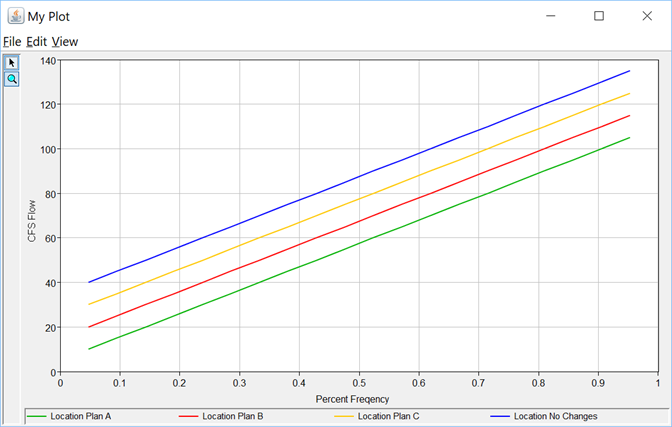PairedDataContainer functions for large data sets or segments of a data set
public void allocateSpace(double xOrdinates[], int numberCurves)
public void setXOrdinates(double xOrdinates[])
public void setYOrdinates(double yOrdinates[][])
public void setStartingEndingCurve(int startingCurve, int endingCurve)
public void setStartingEndingOrdinage(int startingOrdinate, int endingOrdinate)
public int getStartingCurve()
public int getEndingCurve()
public int getStartingOrdinate()
public int getEndingOrdinate()
JAVA
Example: Paired Data Rating table
//This example stores and retrieves a simple rating table, then displays in in a data table.
import javax.swing.UIManager;
import hec.dataTable.HecDataTableFrame;
import hec.heclib.dss.*;
import hec.io.PairedDataContainer;
// A simple sample of code to demonstrate storing and retrieving
// paired data for a rating table
//
public class ExamplePairedData1 {
public static void main (String args[]) {
try {
javax.swing.UIManager.setLookAndFeel(UIManager.getSystemLookAndFeelClassName());
}
catch (Exception ignore) {}
// Gen up the data
// double xOrdinates[int numberOrdinates]
double xOrdinates[] = new double[200];
// double yOrdinates[int numberCurves][int numberOrdinates]
double yOrdinates[][] = new double[1][200];
// Gen up data to store
for (int i=0; i<200; i++) {
xOrdinates[i] = (double)(i + 1);
yOrdinates[0][i] = (double)(i + 1) * 100.0;
}
PairedDataContainer pdc1 = new PairedDataContainer();
pdc1.setName("/Basin/Location/Stage-Flow/Rating Table/Java Sample//");
pdc1.setValues(xOrdinates, yOrdinates);
pdc1.setXUnits("Feet");
pdc1.setXType("Linear");
pdc1.setYUnits("CFS");
pdc1.setYType("Linear");
HecPairedData dssPairedData1 = new HecPairedData();
dssPairedData1.setDSSFileName("C:/temp/Example7.dss");
// We could have set with setDefaultDSSFileName for the entire example
int status = dssPairedData1.write(pdc1);
dssPairedData1.done();
if (status != 0) return;
// Read the data
PairedDataContainer pdc2 = new PairedDataContainer();
pdc2.setName("/Basin/Location/Stage-Flow/Rating Table/Java Sample//");
HecPairedData dssPairedData2 = new HecPairedData();
dssPairedData2.setDSSFileName("C:/temp/Example7.dss");
status = dssPairedData2.read(pdc2);
dssPairedData2.done();
if (status != 0) return;
// Show in a table
HecDataTableFrame table = new HecDataTableFrame(null);
table.setData(pdc2);
table.setVisible(true);
HecDataManager.closeAllFiles(); // Only at the end of the program
}
}
JAVA
Example: Paired Data Frequency Curve
// This example stores and retrieves a flow-frequency curve.
// Since the flow-frequency data set contains several curves, each curve is given a label to identify it.
// After the data has been stored, it is read and displayed in a plot.
import java.util.Vector;
import javax.swing.UIManager;
import hec.gfx2d.G2dDialog;
import hec.heclib.dss.*;
import hec.io.DataContainer;
import hec.io.PairedDataContainer;
// A simple sample of code to demonstrate storing and retrieving a flow-frequency curve set
//
public class ExamplePairedData2 {
public static void main (String args[]) {
try {
javax.swing.UIManager.setLookAndFeel(UIManager.getSystemLookAndFeelClassName());
}
catch (Exception ignore) {}
double xOrdinates[] = new double[20];
// numberOrdinates = 20;
double yOrdinates[][] = new double[4][20];
// numberCurves = 4;
// Gen up data to store
for (int i=0; i<xOrdinates.length; i++) {
xOrdinates[i] = (double)(i + 1) / (double)(xOrdinates.length + 1);
}
for (int i=0; i<4; i++) {
for (int j=0; j<xOrdinates.length; j++) {
yOrdinates[i][j] = (double)(i + 1) * 10.0 + (double)(j * 5);
}
}
PairedDataContainer pdc1 = new PairedDataContainer();
pdc1.setName("/Basin/Location/Freqency-Flow/Java Sample///");
pdc1.setValues(xOrdinates, yOrdinates);
pdc1.setXUnits("Percent");
pdc1.setXType("Freqency");
pdc1.setYUnits("CFS");
pdc1.setYType("Linear");
String labels[] = new String[4];
labels[0] = "Plan A";
labels[1] = "Plan B";
labels[2] = "Plan C";
labels[3] = "No Changes";
pdc1.setLabels(labels);
HecPairedData dssPairedData1 = new HecPairedData();
dssPairedData1.setDSSFileName("C:/temp/Example7.dss");
int status = dssPairedData1.write(pdc1);
dssPairedData1.done();
if (status != 0) return;
// Read the data
PairedDataContainer pdc2 = new PairedDataContainer();
pdc2.setName("/Basin/Location/Freqency-Flow/Java Sample///");
HecPairedData dssPairedData2 = new HecPairedData();
dssPairedData2.setDSSFileName("C:/temp/Example7.dss");
status = dssPairedData2.read(pdc2);
dssPairedData2.done();
if (status != 0) return;
// Show in a plot
Vector<DataContainer> v = new Vector<DataContainer>();
v.add(pdc2);
hec.gfx2d.G2dDialog plot = new G2dDialog(null, "My Plot", false, v);
plot.setVisible(true);
HecDataManager.closeAllFiles(); // Only at the end of the program
}
}
JAVA
